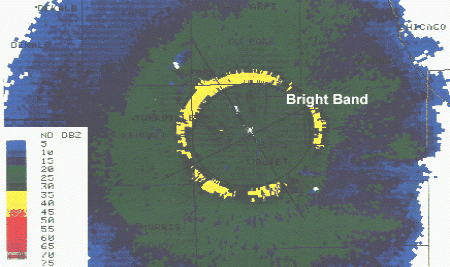
|
Precipitation typically forms high in the atmosphere where the temperature is below freezing. As ice crystals form aloft and fall toward the surface, they collect each other to form large snowflakes. As the snowflakes fall, they pass through a level where the temperature rises above freezing. When the snowflakes start to melt, they initially develop a water coating. Water is about 9X more reflective than ice at microwave wavelengths, so these large wet snowflakes produce a high reflectivity.

Image by: NWS
As the flakes continue to fall and melt, they collapse into rain drops. The rain drops are smaller and fall faster, so both the size of the particles and their concentration are reduced, reducing the radar reflectivity. All of these processes lead to the formation of a narrow ring of high reflectivity near the melting level. This ring, called the "bright band", can be seen on the image above.

mdr images |
|

Velocity Patterns |




